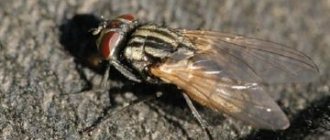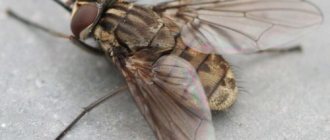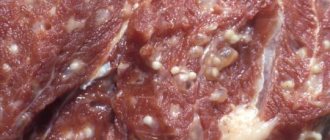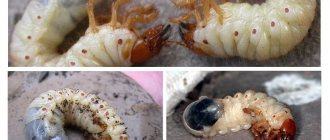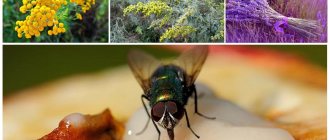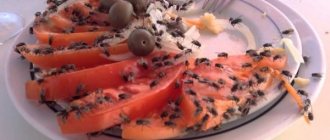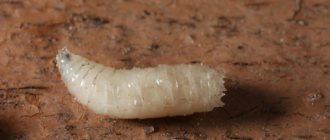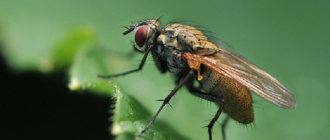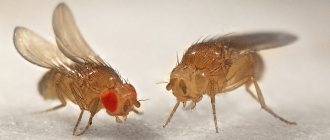Mimicry is the external similarity between different species of living beings that belong to different genera, families and orders. This is well illustrated by the hoverfly fly.
Outwardly, it is very similar to a wasp, so its other name is the wasp fly or syrphid (lat. Syrphidae). They belong to the order Diptera. These insects are widespread throughout the globe.
Larva
Adult insects appear in the garden towards the end of spring. Wasp flies mate in midsummer. They fly actively until the beginning of August. Each female syrphid lays up to 200 white eggs. She leaves them on grassy areas, plant stems, soil or tree branches. It depends on the type of hoverfly.
Many people know what maggots (blowfly larvae) are. In the hoverfly, the larvae are also maggots, but their length does not exceed 10 mm.
The species of syrphid larvae affects their food preferences:
- predators - prefer aphids or grass fleas;
- herbivores - the basis of their diet is plant bulbs;
- aquatic - feed on dead organic matter;
- arboreal - prefer dead plant tissue, as well as excrement of farm animals.
Gradually, the grown larva of the hoverfly forms into a puparia. It is a false cocoon or molting skin of an adult larva. An adult insect matures inside the puparia. She stays in the cocoon for up to 2 weeks. Having flown out from the puparia, after 1-2 hours it spreads its wings and is ready for long flights.
What are the features of reproduction?
An adult female is capable of laying 150-200 eggs. The eggs are small in size and white in color. The number of clutches directly depends on external conditions. The fly lays eggs in the stems of plants, as well as on the buds of trees. Within a week, the larvae hatch. In appearance they resemble maggots. Throughout the month, the representative will actively eat for full development.
Over time, pupation occurs. Adult flies begin to fly in July-September. The larvae go to winter at the first cold snap.
Hoverfly larvae pose a danger to spider mites and small insects. A fly can also eat hundreds of aphids.
You will learn more about hoverflies in this video:
Types of hoverflies
Hoverflies are divided into different types. The classification is based on the feeding habits and lifestyle of its larvae.
Among them there are 4 main types:
- entomophages (predators);
- herbivores;
- aquatic;
- woody.
All hoverflies are divided into beneficial and harmful. The latter are much more common.
Water
Syrphida aquaticus most often inhabits small natural reservoirs in which there is standing water (lakes, swamps). Their larvae have special long proboscises that function like a breathing tube for divers.
Thanks to this part of the body, insects can breathe air underwater . They feed on tissue decay products or organic matter.
Beekeeper
Ilnitsa or beeworts are representatives of a special genus of hoverflies. They come in large or medium sizes. Visually very similar to bees or bumblebees. Adult flies feed on flower nectar.
The larvae inhabit water bodies rich in rotting vegetation, manure, and some species are even found in human latrines. Sometimes people swallow the eggs of the tenacious siltweed. Once in the intestinal tract, the eggs hatch into larvae and provoke the development of myiasis.
Ordinary
The common hoverfly or flower fly reaches a length of up to 12 mm. Adults are excellent pollinators, while larvae are entomophagous.
The latter lead a predatory lifestyle. They eat aphids, small mites, fleas, and their eggs. The larvae are capable of consuming up to 200 pests in 24 hours.
Onion
There are also real pests among syrphids. For example, onion hoverflies actively lay eggs on onion feathers, causing great harm to this garden crop.
After 10 days, the eggs hatch into larvae that damage the bulbs, causing them to rot. In addition, this pest damages flower bulbs: tulips, gladioli, daffodils, hyacinths.
Osovidnaya
The wasp belongs to the arboreal hoverflies. This insect has a very strong external resemblance to the common wasp. The larvae of the hoverfly wood fly feed primarily on rotten wood. An adult insect is quite large. The length of its body can be 20 mm.
Effective remedies against onion fly
If preventive measures were not taken or for some reason did not work, it’s okay, since it’s easy to fight the onion fly. This insect does not like strong odors, so the beds should be sprayed with decoctions of valerian, wormwood, wild rosemary, infusions of pine needles and mint. These products are safe for people and plants, for this reason they can be used frequently and without fear for the harvest.
You can also remove onion flies using other substances. Experienced gardeners recommend using wood ash. This natural remedy will bring double benefits: firstly, it will destroy the pest, and secondly, it will serve as a fertilizer for the soil, which will have a positive effect on the yield of growing crops. As a rule, in the spring and autumn months there are always dry tree branches on the site. After burning them, ashes remain, which can be collected and used when an insect appears. To prepare the solution, add ash to water and water the plantings.
The next proven remedies for onion flies are peat and manure. Peat is no less effective than ash, but it is used much less frequently, since it is not available in all regions of the country. Manure repels insects and at the same time fertilizes the soil. It can be used in two ways: the first is to dissolve it in water and water the beds with the composition, the second is to spread it on the site.
An effective remedy for onion flies is tobacco dust, which is sold in specialized retail and online stores that sell gardening products. This product can be used in its “pure” form, that is, scattered over the surface of the soil at the rate of 1 tbsp. l. component per 1 m² of area. It is often used in combination with sand or naphthalene in a 1:1 ratio. You can pollinate the soil with a mixture of tobacco dust, wood ash and ground pepper. After the procedure, weeding should be carried out. You can also spray infected beds with tobacco infusion. To prepare it, you need to add 200 ml of the product to 10 liters of water and let the composition brew for two days.
Folk remedy - salt for onion fly
To get rid of the pest, you need to water the area with saline solution. An excess of the product should not be allowed in the ground, as this may negatively affect plant growth. Considering the fact that the onion fly does not like salt, the first treatment is carried out 14–20 days after the bulbs germinate. The solution is prepared in the proportion of ⅓ part of a package of salt per 10 liters of water. It is recommended to repeat the procedure with the same composition two weeks after the first, but in an increased concentration of the main component (0.5 packs). The third time you should treat the onions against onion flies with salt after three weeks in the proportion of ⅔ package per 10 liters of liquid. 4–5 hours after the planting procedure, you need to water it with clean water. It is recommended to pour the saline solution under the roots of plants without affecting their above-ground parts.
Onion fly: how to fight it chemically
There are many methods for exterminating insects. Each person chooses which one to use individually. Chemical preparations for onion flies help quickly get rid of the pest, but create the danger of pesticide accumulation in grown products.
An effective way to rid green spaces of the pest is to water them with a solution of ammonia. To prepare it, add 3 tbsp to a standard 10–12 liter bucket of water. l. drug. Watering the plantings should be done in the afternoon.
Even if it was possible to destroy insects after one procedure, for preventive purposes it must be repeated twice, because flies can settle in the same place up to 3 times per season. The frequency of treatment is once a month.
Onion fly, how to fight it using chemical methods:
- Spraying the area with a solution of the drug Dachnik (concentration 0.15%), gives an effect of 77.8-79.3%.
- Sprinkle onto the soil surface and then loosen it with a preparation designed to combat soil pests. The recommended dosage of the product is 50 g per 10 m².
- During the mass summer of insects, use insecticidal preparations to combat the onion fly.
- Treatment with pesticides and the insecticide Bazudin (20 g of granules per 100 m²) during oviposition shows good results in the destruction of pest larvae. It can be applied during sowing of the material and after 2-3 weeks in the furrows next to the young seedlings, followed by watering.
Important... Traditional methods of combating onion flies are more preferable than chemical ones. They are more economical and guarantee an environmentally friendly harvest.
Onion fly, larva: how to fight
The onion fly larva poses a threat to leeks, chives, onions, garlic and bulbous flowers. It makes its way through the husk into the inside of the onion and destroys its fleshy scales.
Four ways to remove pests from your garden:
- In the fall, dig up the soil after the onions, so the onion fly larvae will end up on the surface and die from the cold.
- Use deworming medications. To prepare the composition, dissolve 5 tablets of the product in 10 liters of water.
- Mix naphthalene and sand in a ratio of 1:10. Sprinkle the resulting mixture onto the ridges infested with small worms.
- Water the plants and plantings with a solution of laundry soap (50 g of solid product per 10 liters of water).
What does it look like
If you catch a glimpse of a hoverfly fly, you may get the impression that it is a wasp or a bee. This is very useful for such insects, since birds, seeing such a coloring, do not consider them as prey, but fly past. The body of wasp flies can be both slender and large.
The average size of an adult is 4-25 mm. A distinctive feature of these insects is the absence of hard hairs covering the body, which are found in flies of other families.
Syrphidologists study these flies with great interest. They are amazed by the virtuosity of the hoverflies during flight. Syrphids are capable of flying for a long time and at the same time they carry out all movements very quickly. But if such a need arises, then they freely hang in one place.
Male wasp flies actively defend their territory . They hang in one place for a long time, driving away other applicants. Rivals, seeing that this territory is occupied, fly in search of other places. After hovering, insects are able to abruptly change their flight direction. It is interesting that even the mating process for many of them occurs during flight.
Features of color
The body of wasp flies is covered with fine fluff, similar to that of bumblebees. The color is dark with yellow or reddish elongated stripes covering the back and abdomen.
The peculiarity of the color is that flies can be easily confused with bees, wasps or bumblebees. They can be distinguished only by the absence of a second pair of wings.
Mimicry
As already mentioned, syrphids are very similar in appearance to stinging insects - wasps, bees, bumblebees. The hoverflies seem to be camouflaged as them, and their striped black and yellow coloring helps them in this. But upon closer examination, you can notice the difference:
- syrphids have much shorter antennae (for example, a wasp has antennae up to 1 cm);
- they are smaller than wasps, bees, etc. (excluding especially large species);
- they have 1 pair of wings, while the stinging ones have 2.
But even with these minor differences, nothing prevents syrphids from feeling quite at ease and boldly in nature: their external imitation (mimicry, from the English word mimicry - disguise, imitation) of dangerous stinging insects is so believable that few birds risk attacking them, especially if you have already had a sad experience of contact with a wasp. But all this is despite the absolute harmlessness and even some defenselessness of the syrphids.
Nature has endowed these flies with such a coloring, thanks to which they may not be afraid of attacks from enemies. Hence several more popular names for hoverflies: bee-eater, wasp-fly, wasp fly, etc.
Harm and benefits of beeweed
By feeding on pests such as aphids, hoverfly larvae protect fruit trees or shrubs from such parasites. And if they live in mountainous areas where the number of bees is reduced, then syrphids provide a great service to people. They actively pollinate flowering crops, significantly increasing their yield.
On the other hand, some species of wasp flies cause serious damage to bulb crops. Gardeners and flower growers suffer from the larvae of such insects when they damage onions, garlic or bulbs of tulips, daffodils, and hyacinth. Damaged plants slow down their growth and often wither. And harvested onions or garlic, which have been attacked by syrphids, are stored very little and quickly rot.
Struggle
If you notice hoverfly larvae in your bulbous plantings, you need to take immediate action. In this case, proceed as follows, using both means of destruction and preventive measures:
- Severely damaged plants are removed from the site and burned.
- The rest of the plantation is treated with conventional insecticides: Aktara, Decis, and so on.
- The planting sites for daylilies are changed annually, alternating them with other crops.
- Carrots are added to lily plants, the smell of which repels onion flies and hoverflies.
- Bulb crops are also saved by early planting, so that by the time the pests fly out they are already strong enough.
- Preventive treatment with odorous substances is used: tobacco dust, mothballs, ash, hot pepper and the like.
- Mulching and loosening the soil prevents its compaction, which is a barrier for pests.
After harvesting bulbous crops, if there is a suspicion of hoverfly infestation, it is advisable to treat the soil with a solution of copper sulfate.
At the end of the article, we recommend that our readers watch an interesting video about the hoverfly.

